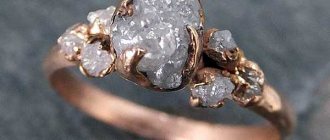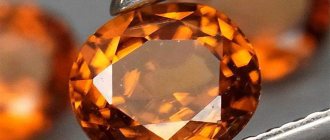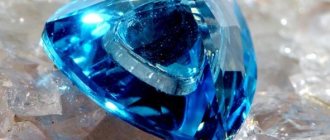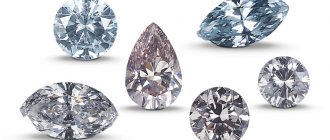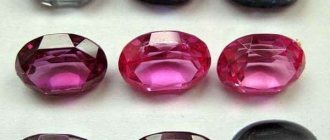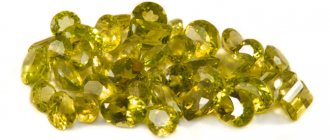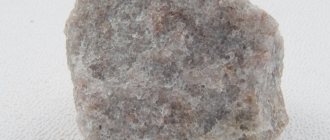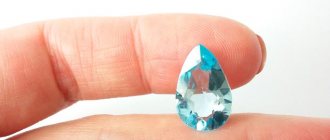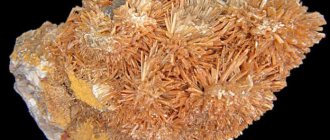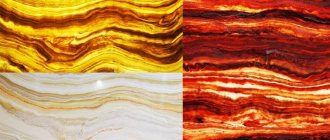All topazes are truly beautiful stones. They are considered precious, which is reflected in their value. The types of stone depend on its shade.
But relatively recently, from the point of view of world history, imperial topaz was born. And gemologists wondered which stones should be called imperial and what selection criteria exist for a crystal to receive such a name?
The history of the name topaz
Initially, topazes were mined in many countries, including Russia. Most often, when people hear the word “topaz,” they think of a stone with a bluish tint. But orange (yellowish) specimens were discovered in Brazil.
From that moment on, they began to be called imperial. This was just a PR stunt, since emperors, from the point of view of history, could not wear the stone, and there is no confirmation of such assumptions. Now the situation has not changed; the right to obtain the name “topaz imperial” still belongs to the miners of yellow-orange specimens in Brazil.
Another interesting fact is that there was a criterion among gemologists that the color of the stone should correspond to the shade of lightly salted salmon. At the same time, topazes of the same shade, found, for example, in Ukraine and retaining their color, still do not receive the name “imperial topaz”.
At the same time, the price for imperial specimens increases at least ten times in comparison with topazes of other origins. Now businessmen from Brazil, when they find pink or purple stones, also classify them as imperial.
You can see the stone with your own eyes not only on jewelry or in catalogs, but also in the Diamond Fund of the Order of the Golden Fleece, which is considered the most elite in Europe. Order badges were awarded only to aristocratic families, monarchs and kings. Decorating orders with topazes began in the 19th century, which was considered a symbol of nobility and unity.
Yellow shades
Among the best-selling is the famous yellow mineral, the price of which starts at $50 per carat. Its distribution in nature, compared to other species, is quite extensive. Therefore, it is a common item in jewelry stores around the world.
In addition to the standard yellow, topaz has other similar shades:
- tea (pale yellow);
- honey (amber-golden, with a soft sunny glow).
Esotericists claim that the pebble helps in the treatment of the respiratory tract, colds, ARVI, asthma and bronchitis. According to astrology, yellow crystals are suitable for Virgo, Leo, Libra and Gemini. A honey shade is a good option for Aries.
Imperial topaz color
Topazes of excellent gem quality, mined in the Brazilian region of Oro Preto since 1730, have the right to be called “imperial”. However, in the designated places, gems of very different colors are found. Which of them can be called imperial, which cannot?
Modern gemology does not impose strict restrictions on the color of imperial topaz. But it outlines the boundaries! Only those Brazilian topazes are called imperial, which are not far from the standard orange-brown color.
The great advantage of imperial topaz is its noticeable pink tint. Moreover, there is an opinion that only pinkish topazes with a golden tone have the right to be called imperials!
However, such ideas have few followers. There are many more people who want to expand the range of imperial topazes to include stones of both yellow and lilac colors. Of impeccable quality, of course.
While the world's gemology is wondering how to deal with the conflicting desires of topaz miners, traders have come up with a clever move. The inscriptions appeared on the price tags: “Imperial-colored topaz... The price, with a clear conscience raised many times higher than usual, still does not reach the imperial level. The buyer gets the impression that he is very lucky!
What are topazes silent about?
A good topaz is like a clever bride: it does not reveal the secrets of past events under any pretext. But do imperial topazes have anything to hide?
It turns out there is. Most defect-free Al2SiO4 crystals appear lightly colored and yellowish. Verified methods of physical processing of the stone give amazing results: crystals of natural topaz, after heating or irradiation, acquire the richness of the color of real “imperials”! At the same time, it is not possible to identify a fake: the coincidence between a human creation and a natural rarity is complete.
This is why the most sophisticated collectors are more willing to purchase stones that have defects characteristic of Brazilian deposits. This is the only way to eliminate errors!
Stone deposit
In addition to the already known Brazil, the stone was found in such territories as:
- Pakistan (Asia).
- Russia.
- Ukraine.
At the same time, topazes from Brazil, as well as pinkish stones from Pakistan, are considered a full-fledged imperial specimen. The commercial side of the issue is not always profitable, since there are few stones in the deposits, and the business becomes unprofitable.
Although there are also areas where stone has been mined for more than two hundred years, for example, Ouro Preto in Brazil. They are the ones who provide the world market with such specimens. And the gross production for one year is only 100 thousand carats. This indicator does not take into account losses during stone processing.
The buyers in this trade operation are Japan and America. And Paris is also partial to imperial topazes. It is this stone that is in the spotlight among all the stones mined in Brazil, since it brings a lot of income to the country. It is impossible to say what is driving the demand: the popularity of the stone or the fact that the orange color remains at the peak of fashion.
Where is it mined?
The most famous stone deposit was once Rudnaya. Today, it has only historical interest. Brazil is the largest supplier of such a beautiful stone as imperial topaz. Where can you get great samples? For example, in the Imperial mine, located near Ouro Preto. About 40 kilograms of stone are taken out from here every month, of which only 600 grams will be processed.
Few crystals exceed 4 centimeters. The associated minerals have little economic value or significance as crystal specimens. The following occur: ilmenite, smoky and milky quartz, schorl, rock itacoluminum and topaz. The exceptional crystals form two types: hematite "roses" growing in topaz-laden veins have a diameter of up to 20 centimeters.
Sometimes small but beautiful rutile crystals appear. Packed with people, crates of chickens and ducks, and piles of cargo, the train stopped at every small village along the way. A journey that took just over four hours by train can be reached by car in about an hour.
Topazes are also found in Zimbabwe, Sri Lanka, Russia (transparent blue in the Urals, violet-red in Siberia), Pakistan, Nigeria, Namibia, Mexico, Madagascar, Japan, China, USA, Burma, Australia, Northern Ireland, Scotland. In 1964, a hundred-kilogram one was found in Ukraine.
A bulldozer clears overburden at the Vermeloo mine near Saramenja, sometimes crashing into old winding tunnels that have hidden lost buckets, lamps and tools over the years. Rodrigo Silva's Capao mine is also bustling with activity. Newly mined topaz crystals are similar in quality and can match the dimensions found many years ago. Best of all, gemstone production is at an all-time high and optimism permeates the entire topaz mining region.
He is also the author of Minerals and Crystals of the World and has written for many publications in Europe, Australia and the USA. Bancroft is a renowned lecturer on mines, minerals and gemstones. Unlike many "armchair writers" who simply recycle what has appeared in other books, Dr. Bancroft spent years traveling the world like a modern-day Herodotus, visiting hundreds of remote and fascinating mineral and gem deposits, and interviewing miners and locals residents. Bancroft revealed a wide range of information, some of which had never been published before.
Characteristics and cost of topaz
If we talk about the properties of the stone, from a physical and chemical point of view, there are the main qualities that concern jewelers:
- Hardness reaches eight to nine on the Mohs scale, which means that topaz is only one point behind the hardest mineral on Earth: diamond.
- But the molecular weight of imperial topaz is exactly the same as that of diamond and is 3.53.
- The color depends on the impurities and the structure of the crystal lattice of the stone.
- The chemical composition of the element is Al2SiO4. The natural shade is slightly colored, yellowish.
- The high temperature of refraction, as well as the chemical composition, gives topaz a metallic sheen. If you look at the imperial from different angles, you can detect a slight change in shade.
But the large number of shades of crystals allows us to conclude that topaz is unique. The color range includes shades from gold, cognac to peach and even cherry color. This factor is influenced by the presence of phosphorus in the composition of the stone. The most unique shades are considered to be sherry, lilac and purple specimens.
Imperial topaz as part of jewelry is rarely found on ordinary jewelry counters. This is because the stone is unique; in most cases, products with it are made to order. Only large factories cooperate with topaz suppliers from Brazil. If we talk about a crystal, the cost of one carat ranges from 200 to 400 euros.
A cherry shade of topaz will cost up to 2 thousand euros per carat. The average size of stones is 6-8 carats. And topazes over 20 carats are sold at auctions or stored in museums. The cost also depends on the cut of the stone and the number of defects.
And the possible processing of the stone will also affect the price of the product. The thing is that imperial topaz can be exposed to heat or doused with special chemicals. Of course, such specimens cannot fully be called imperial topazes.
But not all stones can be heated to a certain temperature and get a stone that looks like an imperial. The thing is that in order to change color, the presence of chromium in the stone is necessary, and there are few such specimens. It is desirable that the stone does not have impurities, cracks or other defects. In addition, if the mineral does not have enough gases and liquids in its composition, this fact will lead to its explosion when the stone is heated.
It is very difficult to determine an artificially created imperial from a real one: this can only be done by professionals after the stone has passed an examination.
It was determined that stone that has undergone heat treatment no longer changes color. But natural topazes, being crystals, can gradually fade under the influence of direct ultraviolet radiation.
Are there many fakes among the “imperials”?
Fortunately, there are very few natural topazes that can become “imperial” after modification. In order for an Al2SiO4 crystal to acquire a pink tint, it must initially contain an admixture of chromium.
There are very few such aluminosilicates in nature. In addition, most of the gems found are far from the required level of quality. Cracks, large inclusions, bubbles, and opaque areas devalue the stone.
Chromium-containing topazes of good jewelry quality are used. Heat treatment (forty-five minute exposure at 450˚C in an oxygen-free environment, or 40 minutes at 565˚C in the presence of oxygen, etc.) brightens the crystal and reveals its red tones. Depending on the intensity of the initial color, you get quite imperial topazes of different tones.
By the way, heat treatment also hardens topaz. The strength and wear resistance of the heated “imperial” is at the highest level! Properly heated topazes do not lose color either under the sun or during long-term storage.
Pink
Titanium and hydroxyl give the mineral a palette of pink shades. Collectors and experienced jewelers are willing to pay a lot of money for this rare natural treasure. On the jewelry market, this type of topaz is valued from $500 to $3,500 per carat.
Bioenergetics specialists use the pink mineral to eliminate poisoning and treat colds and respiratory diseases. They claim that such an amulet brings peace and spiritual harmony to the owner. The healers of antiquity also believed that they used pink crystal in the treatment of people suffering from depression, insomnia and prone to causeless anxiety.
The magical side of the stone
Of course, like other crystals, the stone has magical properties. True, they are rarely used. Imperial topaz is often purchased as jewelry to emphasize wealth and status. But nevertheless, such a product becomes an amulet for the owner and protects him from various vices.
The stone can awaken love and passion in relationships with a partner, and will also bring prosperity to the home and help improve mental abilities. Topaz also relieves neuropsychic disorders, energizes, and helps to have a child.
Imperial topaz is a beautiful and expensive stone that can compete even with diamonds. It will definitely highlight your image and position in society. The stone is suitable for women of any age and type; with it they will look luxurious. When wearing such jewelry, the main thing is to take care of them, then topaz will retain all its properties for a long time.
Red
This is a very rare type of topaz, along with pink. Because of this, it is often counterfeited. Sometimes unscrupulous sellers pass off synthetic rubies, red spinels or quartz as lower-priced ones. Outwardly, they resemble the original bloody topaz, the price of which varies from 500 to 2500 dollars per carat.
The red variety of topaz is a desirable decoration because it is rare and, according to esotericists, has healing properties. They believe that bloody topaz helps people suffering from nervous system disorders, relieves fears, groundless worries and lack of sleep. Astrologers and magicians believe that red crystals help to find a soul mate and favor happy and long-lasting love. They will be an excellent amulet for Aries.
